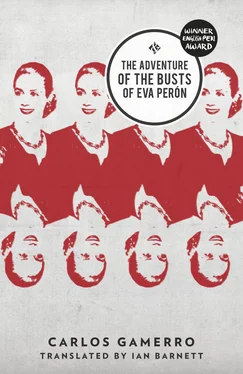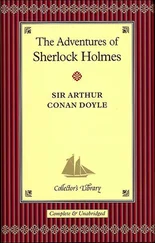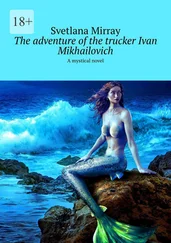Carlos Gamerro - The Adventure of the Busts of Eva Perón
Здесь есть возможность читать онлайн «Carlos Gamerro - The Adventure of the Busts of Eva Perón» весь текст электронной книги совершенно бесплатно (целиком полную версию без сокращений). В некоторых случаях можно слушать аудио, скачать через торрент в формате fb2 и присутствует краткое содержание. Год выпуска: 2015, Издательство: And Other Stories, Жанр: Современная проза, на английском языке. Описание произведения, (предисловие) а так же отзывы посетителей доступны на портале библиотеки ЛибКат.
- Название:The Adventure of the Busts of Eva Perón
- Автор:
- Издательство:And Other Stories
- Жанр:
- Год:2015
- ISBN:нет данных
- Рейтинг книги:3 / 5. Голосов: 1
-
Избранное:Добавить в избранное
- Отзывы:
-
Ваша оценка:
- 60
- 1
- 2
- 3
- 4
- 5
The Adventure of the Busts of Eva Perón: краткое содержание, описание и аннотация
Предлагаем к чтению аннотацию, описание, краткое содержание или предисловие (зависит от того, что написал сам автор книги «The Adventure of the Busts of Eva Perón»). Если вы не нашли необходимую информацию о книге — напишите в комментариях, мы постараемся отыскать её.
Carlos Gamerro's novel is a caustic and original take on Argentina's history.
The Adventure of the Busts of Eva Perón — читать онлайн бесплатно полную книгу (весь текст) целиком
Ниже представлен текст книги, разбитый по страницам. Система сохранения места последней прочитанной страницы, позволяет с удобством читать онлайн бесплатно книгу «The Adventure of the Busts of Eva Perón», без необходимости каждый раз заново искать на чём Вы остановились. Поставьте закладку, и сможете в любой момент перейти на страницу, на которой закончили чтение.
Интервал:
Закладка:
But the dogs — the hypercritics — wouldn’t give in and reappeared again and again over the next few boxes, this time in the form of four young women decked out in furs, hats and jewellery, waving little French and English flags, while among them strutted a blonde-haired, pot-bellied, Stetsoned Texan with an American flag emblazoned on his dickey. The forces of the anti-people , from the oligarch traitors and the petit bourgeoisie to the socialist and communist intellectuals who had never seen a worker close up, led by the Yankee ambassador, Spruille Braden, call for Perón’s head and obtain his arrest , read the text, and over the next few boxes a dignified if somewhat browbeaten Perón was shown being dragged away by police from the arms of a tousled Eva wearing a simple flowery dress, at first tearful and distressed (‘ I had never felt so small or helpless as I did in those days… ’), then suddenly looking fiercely and resolutely into the camera (‘ But then I took to the streets in search of friends who could still do something for him ’), then talking to the military, priests and politicians with their stony faces (‘ Up at the top I met only with cold, calculating, “sensible” hearts, the hearts of “ordinary men” , hearts at whose contact I felt sick, afraid and ashamed ’); then with workers in helmets and berets under bubbles shouting ‘ Viva Perón! Viva Eva! ’, housewives dropping their shopping to follow her, passionate shanty-dwellers with clenched fists raised aloft ( But as she descended from the neighbourhoods of the rich and proud to the poor and humble, people’s doors began to open wide ). The sequence climaxed in an elongated box featuring an Evita who evoked Delacroix’s Liberty (though with no breast on display), brandishing an Argentine flag and leading the hopeful, swarthy crowd of workers, people, masses who first burst onto the Argentine political scene on that 17th October 1945 and made their voices heard , and below: ‘ Ever since that day I have believed it cannot be hard to die for a cause you love .’
Overleaf Marroné came across a double-page spread showing the Peronist tide filling Plaza de Mayo and clamouring for Perón’s freedom in a variety of bubbles; a box with the cabecitas dangling their feet in the fountain (both apparently archive photos); and a roundel of the photonovel’s two leading lights: an exultant Perón, with one arm raised aloft and the other around Eva’s wasp-waist. Like Venus from the sea , read the pithily overinflated caption, Eva Perón is born of those million mouths demanding the freedom of one man .
So she too had known doubt and dejection, the dark night of the soul, thought Marroné, straining his abs again. Her acting career was over, fallen by the wayside along with the man who had raised her to the top; the enemy had won the day, all doors had closed, and she had even been beaten up in the street by a mob of extremists. Yet her spirit had won through, turning her darkest hour into victory. Bereft of everything, save her determination and courage, she had achieved it all: Perón’s freedom, her marriage to him, a presidential candidacy for her husband and, for her, the title of First Lady at the ripe old age of twenty-six. She had had a clear sense of her mission: to save Perón and set him free, and she had stopped at nothing to fulfil it. What a woman, thought Marroné. Whether you shared her political views or not, it would be mean-minded — the stuff of ‘ordinary men’ — not to acknowledge her leadership qualities.
That was it, felt Marroné, as he gingerly detached his buttocks from the edge of the plastic toilet seat and rearranged them. He could see it clearly now: Evita had followed the Way of the Warrior, she was a samurai woman, and her lord was, of course, Perón: ‘ May it come as no surprise to those who seek my portrait in these pages but find Perón’s instead. I have ceased to exist in myself, and it is he who lives in my soul, master of all my words and feelings, the overlord of my heart and life. ’ As Marroné read, a maxim from The Corporate Samurai came to his mind: ‘Your errors are yours; your successes, your lord’s.’ Or as Eva would have put it: ‘ I was not, nor am I, anything but a sparrow in a vast flock of sparrows… But he was and is a giant condor flying high and sure amidst the mountain tops. Were it not for him, he who came down to me and taught me a different way to fly, I would never have known what a condor was…’
And himself? Marroné too had a clear sense of his mission: he had to save Sr Tamerlán at all costs. The message was clear: all of us have our 17th October in our lives, and his was knocking on the door. He would follow Eva’s example and save Sr Tamerlán, and, like that other 17th October, he would use the workers. He didn’t yet know how, but he’d think of something. He wasn’t the kind of man to stick to the beaten track or always drink from the same well. He would go on ploughing his own furrow while the hypercritics huffed and puffed, and the dogs barked till they were hoarse.
And there was another idea that had begun to nibble at the edges of his mind. If Eva Perón’s exemplary demeanour on 17th October could be his lodestar in the current situation, why not write a book that would take her whole life and career as an example to be emulated? Eva Perón in Enterprise Management , for example, or perhaps something more metaphorical and less pedestrian, like The Sparrow and the Condor . A biography that would keep inessential ideology separate from the core issues: the mettle, the spirit, the will to self-mastery, the capacity for leadership. Had there ever been a better example in history of someone who could overcome the most adverse circumstances, create an image and a name for themselves and, with blind faith, reach the top against all the odds? Eva Perón was a born winner, a self-made woman who had created a product — herself — that millions in Argentina and around the world had bought and consumed. There were — it had to be admitted — powerful reasons why her example had not yet been taken up in the business world: one, the circumstantial anti-capitalist rhetoric and class resentment, which the age and experience that were denied her would no doubt have helped to assuage; two (it was painful to admit, but being economical with the truth would be worse), her being a woman in a still eminently male business environment, where few women could carve out niches for themselves.
Next he flicked through the pages that recounted Evita’s initial faltering steps as First Lady, the gradual refinement of her tastes and the creation of a personal style, as reflected in her wardrobe and hairdos, culminating in her glittering journey to devastated post-war Europe, which, perhaps because of production limitations, the photonovel barely touched on, save to mention that on that tour Eva indulged in rubbing the imperialist countries’ noses in her regal show of wealth . It was a crying shame, because the ‘Rainbow Tour’, as it was known, had wrought a sea change — a genuine metamorphosis — in the young woman from Los Toldos. Before that, Marroné reflected, Eva Duarte, later Eva Perón, had played only pre-existing roles: the young provincial girl who dreams of stardom, the influential lover of a powerful man, even the First Lady… And she had succeeded by making use of the tools of her trade: dresses, hairdos, make-up, studied gestures… But on her trip to Europe she began to enter virgin territory. Eva became Evita, and Evita was no longer an interpretation, but an entirely new creation. And this singular trait of Evita’s manifested itself most fully in the Eva Perón Social Aid Foundation. One photo showed the Foundation’s neoclassical façade; another, the torrent of letters that poured in to her daily, written by mothers with ten or twelve children to look after, unemployed fathers, toothless old men, teenage prodigies with rag balls, the blind, the crippled, the syphilitic; letters from the men, women and children of our people who were no longer alone , who had someone to listen to them and sort out their problems , even asking her from home or the workplace for footballs, clothes, shoes, furniture, false teeth, crutches and wheelchairs, bicycles, sewing machines, toys, cider and panettone for Christmas, or a trousseau for a wedding. These requests were not answered by faceless officials; instead everyone was given a personal audience with Evita : and the photo showed her sitting at her desk, letter in hand, inviting incredulous descamisados to sit down, smiling as she listened to their dreams, their needs, sometimes their life stories; requests that were often nothing but pleas for attention, respect, someone to acknowledge their existence — in a word, love. Evita had set in motion one of the most innovative and truly revolutionary customer service departments in history: the Foundation was a well-oiled customer loyalty machine, once again testing the truth of the maxim learnt by Marroné on his marketing course: ‘A company always makes the same product: happy customers.’ And Evita knew how to promote consumption: rather than giving grudgingly to the people who turned to her, she would egg them on: ‘ Ask for more! The best, the most luxurious, the most expensive! Don’t hold back! It’s all yours now! Feel free and help yourselves! ’ If you asked for a set of bed linen, you went away with a mattress; if a mattress, you got a bed; if a bed, a house. It was impossible not to be touched by the images in the next few pictures: Evita welcoming long queues of ragged paupers, handing out money from her own pocket when the coffers ran out; Evita kissing a leper; Evita sharing her cape with a beggar; Evita giving away her jewellery… ‘ For the love of my people I would sell everything I am and everything I own, and I think I would even lay down my life ,’ she said, and Marroné felt a knot in his throat: because that life, fanned by the breath from millions of mouths, was in fact consuming itself in a furious blaze. The queenly finery had long since been swapped for the republican simplicity of the grey or black tailored suit, and the unruly whorls and waves for the stony coiffure that would soon be made marble: as if refined and purified in that flame burning her inside and out, Evita had been hardening, her dress cleaving to her flesh and her flesh to her bones; her body tensing like a bow and her face sharpening to an arrowhead; her ever more prominent teeth sinking into the air with growing hunger. Perón, on the other hand, was the very picture of health, like a vampire feeding on Evita’s energy, his piggy little eyes sinking like raisins into risen dough, the bloated tortoise face retracting deeper and deeper into the thick neck. And so the eternal couple — that work-team of the idealist and the realist (the very essence of Don Quixote and Sancho) — reached the day when, in front of more than a million faithful all screaming for her to accept, Evita was offered the candidacy for vice president. ‘ The time you have waited for for so long has come, Chinita ,’ a tender, smiling Perón was saying to her on the balcony. ‘ Look, they’ve come from far and wide… Never before in the history of humankind has a woman been more loved by her people… ’ And Eva, with pained countenance, ‘ No, Juan, I can’t ,’ prompting Perón’s astonished reply: ‘ What do you mean you can’t? Who deserves this post more than you? ’ And Evita: ‘ I’m not cut out for posts and protocols… If I were in government, I’d no longer be of the people , I couldn’t be what I am or do what I do… I’ve always lived in freedom. I was born for the Revolution. Look at them. Do you see them? Do you hear them? There is no scene more beautiful, no music more wonderful. My place is among them… I am their bridge to you… I don’t wish to be anything else. Promise me that if one day I am not there for them… you will go on listening… ’ And then, turning to the crowd who chorused her name: ‘ I am worthy not for what I have done, I am worthy not for what I have given up, I am worthy not for what I am or what I have. I have only one thing that is worthy and I keep it in my heart; it aches in my soul, it aches in my flesh and burns in my nerves. It is my love for the people and for Perón. If the people were to ask me for my life, I would give it to them gladly, because the happiness of a single descamisado is worth more than all my life .’
Читать дальшеИнтервал:
Закладка:
Похожие книги на «The Adventure of the Busts of Eva Perón»
Представляем Вашему вниманию похожие книги на «The Adventure of the Busts of Eva Perón» списком для выбора. Мы отобрали схожую по названию и смыслу литературу в надежде предоставить читателям больше вариантов отыскать новые, интересные, ещё непрочитанные произведения.
Обсуждение, отзывы о книге «The Adventure of the Busts of Eva Perón» и просто собственные мнения читателей. Оставьте ваши комментарии, напишите, что Вы думаете о произведении, его смысле или главных героях. Укажите что конкретно понравилось, а что нет, и почему Вы так считаете.











